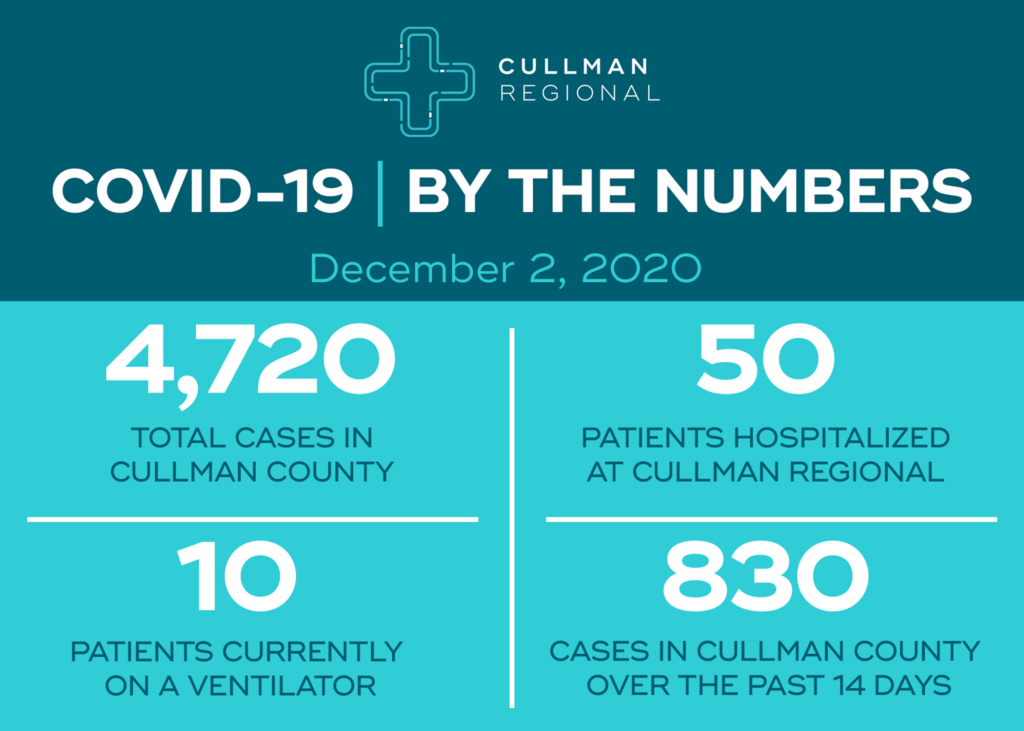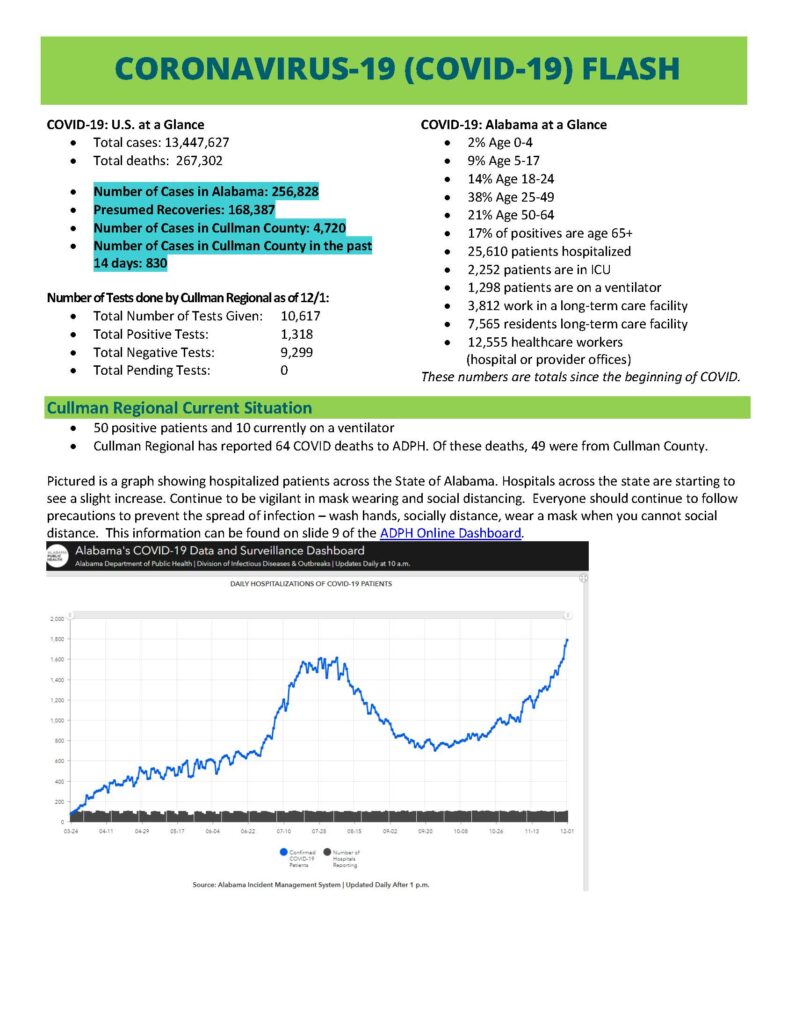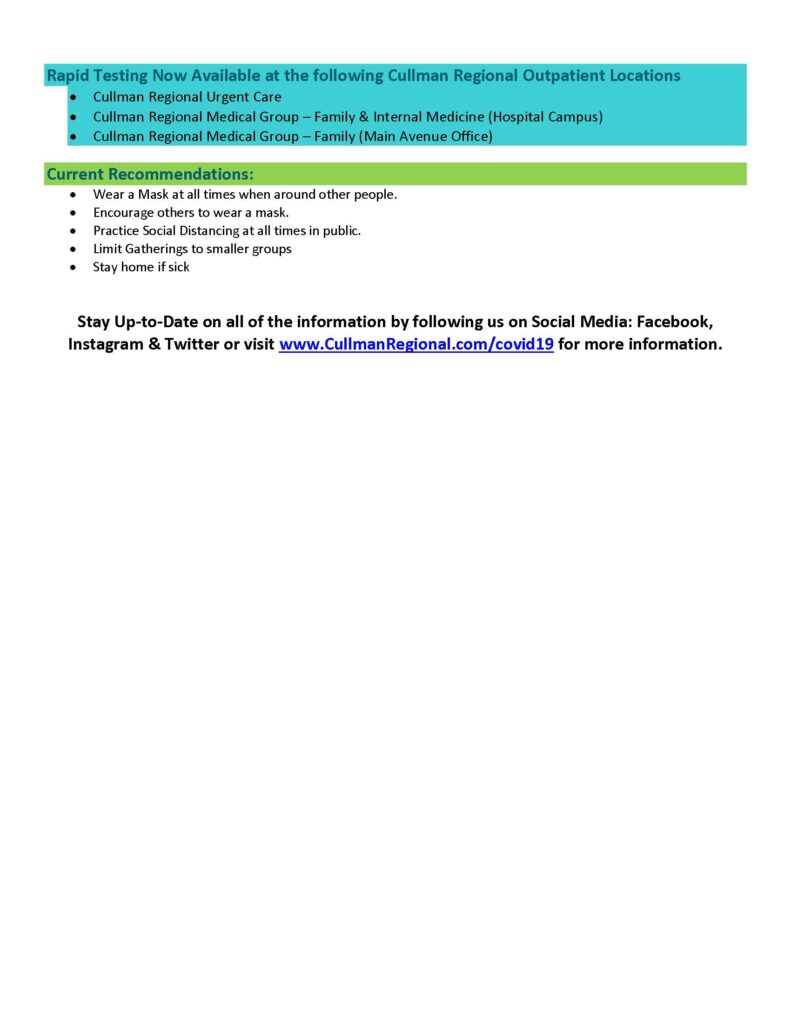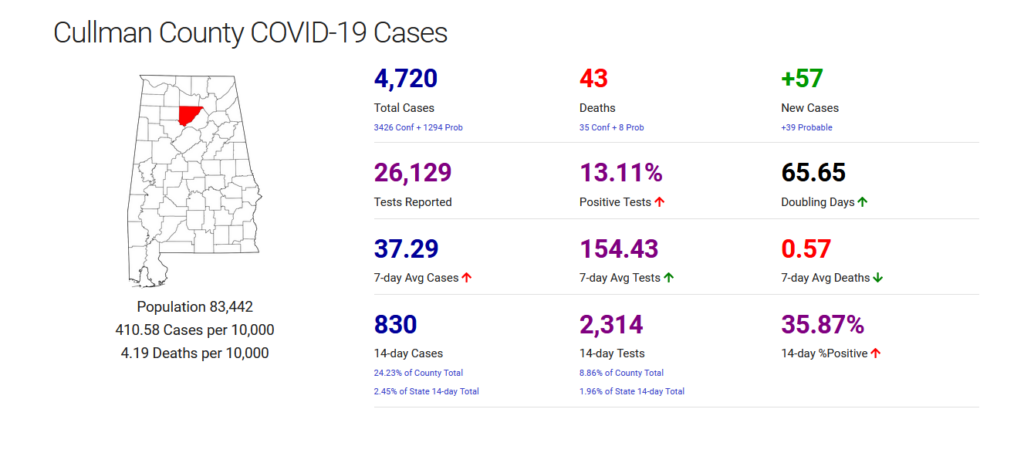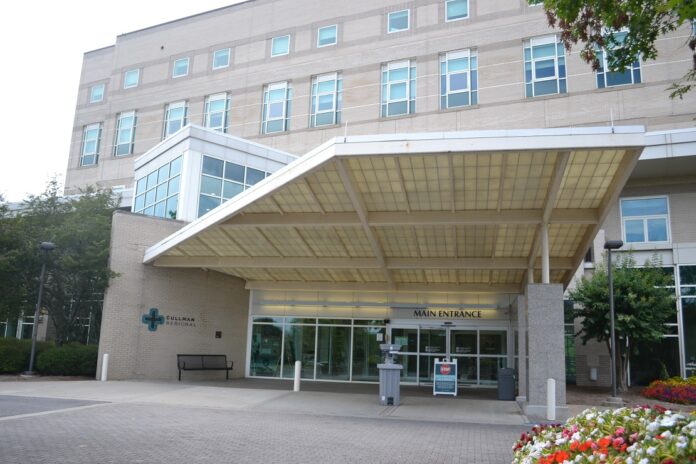CULLMAN, Ala. – Around the country, COVID-19 is surging, and Cullman County is no exception. The county has seen 830 cases confirmed in just the last 14 days, according to the Alabama Department of Public Health (ADPH). Hospitalizations are soaring, too. Cullman Regional has seen record numbers of COVID-positive patients in the last few weeks (beginning the first week of November), prompting questions about the hospital’s capacity in the face of what the ADPH fears will be an even bigger spike in cases and hospitalizations in the weeks after Thanksgiving and throughout the holidays.
Numbers at the hospital fluctuate daily, according to Cullman Regional Vice President, Marketing Lindsey Dossey. On Tuesday, Dec. 1, the hospital reported 81 total patients, with 50 patients hospitalized with COVID-19, or about 62% of the total number of patients. Wednesday, Dec. 2, the total number of patients jumped to 120, with the number of COVID-19 patients remaining at 50, or 40% of the total number of patients. Ten of those COVID-19 patients were on ventilators as of Wednesday, according to the hospital.
Also as of Wednesday, Cullman Regional had reported 64 COVID deaths to ADPH. Of those patients, 49 were from Cullman County.
“We continue to have around 50 patients in the hospital daily with COVID,” Dossey said in an email Wednesday. “We’ve received a lot of questions from the community regarding the hospital’s ability to handle any surge if needed. The reality is that we’ve been in crisis mode since March. Our current surge in cases is due to significant community spread of COVID-19. Therefore, it is completely up to the community as to whether or not we continue to see an increase in hospitalized cases or not. Today, we have 20% vacancy in the hospital, but what happens over the next month or two is completely up to the community members we serve. We need everyone’s help to prevent the spread. We understand that the solutions are inconvenient and require us to do things in life differently than they have been done before, but that’s what we need everyone to do. Now, more than ever, we need EVERYONE to simply do the following: Wear a mask when out, socially distance, wash your hands, limit gatherings of people and stay home if sick.”
Dossey told The Cullman Tribune that Cullman Regional is licensed for 145 beds, and she said the hospital has a lot of flexibility for other areas if needed in a surge.
So, when does Cullman Regional “reach capacity?”
Below is what Dossey shared in an email to The Tribune Tuesday, Dec. 1:
“This question, although seemingly simple, doesn’t have a simple answer.
“All hospitals and health systems across the United States have surge capacity plans that are practiced routinely each year. Although this situation is different and is lasting longer than a typical drill, i.e., tornado with mass casualties and injuries, the planning and preparation for any type of surge in capacity has been done. Rest assured Cullman Regional has processes in place to help ensure we are able to care for those that need care the most. It’s also important to note that Hospitals work together to help meet the needs of the community members we each serve. Whether it’s staff, equipment, etc. hospitals are prepared to step up and help one another in a crisis.
“The key message at this point is – what can the community do to help prevent an overwhelming surge in capacity? We need our community’s help to slow the spread of this virus. Our failure to protect ourselves is catching up to us, and we need everyone to take this seriously and follow the guidelines. Now, more than ever, we need EVERYONE to simply do the following:
- Wear a mask when out
- Socially distance
- Wash your hands
- Limit gatherings of people
“These things will help slow the spread and hopefully prevent any significant surges.
“Regarding our plan and processes, we’ve been in crisis mode since this pandemic began. Some of the key steps we’ve taken to prepare are outlined below.
- We began stockpiling PPE (gloves, gowns, masks, etc.) in March.
- We ordered new lab equipment in April in anticipation of a fall surge in cases. This lab equipment allows for in-house PCR testing which we reserve for patients who need to be admitted to the hospital.
- We ordered 3 additional ventilators in April, again, anticipating a possible fall surge.
- We ordered 5 more ventilators in July after we had our first significant wave of cases in the hospital. These will be delivered this month.
- We have our staff working with other health care facilities – nursing facilities, psychiatric facilities, etc. – daily in order to get patients who need to be discharged to other facilities. This sometimes creates a bottleneck in getting patients out of our facility; therefore, we also need all of our other community health care partners to accept these appropriate transfers in a timely/expedited manner in order to prevent overcrowding.
- We have MOUs (Memorandums of Understanding) in place for staff, equipment, etc. for crisis situations.
- We have already contracted with additional clinical staff to help care for patients in the event of a surge.
- We’ve implemented a tiering system for surgeries, i.e., all emergent surgeries proceed as planned all other procedures are evaluated on a case-by-case basis. This gives us the flexibility to postpone procedures if needed due to capacity.
“Our current surge in cases is due to significant community spread of COVID-19. Therefore, it is completely up to the community as to whether or not we continue to see an increase in hospitalized cases or not. Today, we have 25-30% vacancy in the hospital, but what happens over the next month or two is completely up to the community members we serve. We need everyone’s help to prevent the spread. We understand that the solutions are inconvenient and require us to do things in life differently than they have been done before, but that’s what we need everyone to do. Now, more than ever, we need EVERYONE to simply do the following:
- Wear a mask when out
- Socially distance
- Wash your hands
- Limit gatherings of people
“These things will help slow the spread and hopefully prevent any significant surges which should help until a vaccine is readily available.
“According to ADPH, a vaccine should be available by mid-December or January. However, the distribution of these vaccines is being determined and coordinated by both federal and state governmental agencies. These groups will be determining what vaccines we get, when we get them and who we are supposed to give it to – at least initially. We have purchased and ordered all necessary equipment needed to store the vaccines when they are made available to us.”
Wednesday, Dec. 2, 2020 COVID-19 update from the Alabama Department of Public Health’s COVID-19 Data and Surveillance Dashboard
Total confirmed cases in AL: 213,172* (+3,135 since yesterday)
Probable cases in AL: 43,656 (+793 since yesterday)
Total confirmed deaths in AL: 3,326 (+46 since yesterday)
Probable deaths in AL: 385
Total confirmed cases in Cullman Co.: 3,426 (+57 since yesterday)
Probable cases in Cullman Co.: 1,294 (+39 since yesterday)
Total confirmed deaths in Cullman Co.: 35 (+0 since yesterday)
Probable deaths in Cullman Co.: 8
Total tested in Cullman Co.: 26,129
Total tested in the last 14 days in Cullman Co.: 2,314
Cases in the last 14 days in Cullman Co.: 830
Total tested in Alabama: 1,603,523
Cases in the last 14 days in Alabama: 33,873
Total tested in the last 14 days in Alabama: 117,762
Currently hospitalized in Alabama: 1,801
Cumulative no. of hospitalizations in Alabama: 25,821
Presumed recoveries in Alabama (reported weekly): 168,387
See more details at https://bit.ly/2VjCQbP.
*ADPH Important Notice (12/02/20):
The Alabama Department of Public Health processed a backlog of 706 positive PCR results from a facility on December 1. These will be classified as confirmed COVID-19 cases reported on 12/01/20 even though the tests were performed during November 23 through November 29, 2020. All laboratories are required by law to report all results (including positive and negative results) for SARS-CoV-2 to ADPH. Delays in reporting by required reporters is not within control of ADPH. Processing the backlog will not impact the ADPH COVID-19 Risk Indicator Dashboard. Please see Tab 7A: Daily Number and 7-Day Moving Average of Cases by Infectious Date to see cases by their infectious date and not the date reported.
Copyright 2020 Humble Roots, LLC. All Rights Reserved.
